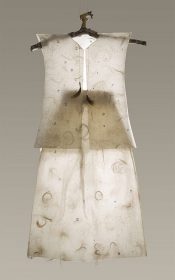Artist Andi Arnovitz Questions Traditional Matrimonial Law
In our current exhibition, Cherchez la femme, a transparent dress seems to reveal everything. The Israeli-American artist Andi LaVine Arnovitz created a delicate work of art from washi paper, hair, and Hebrew letters. Locks of hair adorn the paper dress, hinting at the beauty of its wearer. But how to interpret the other components, the grime and coarse body hair?
The individually placed letters are the key to understanding this piece. They point to the biblical ritual described in the Torah, Numbers 5: 11–31, on which this work is based: a jealous husband could initiate a public trial against his wife if he had reason to suspect her of adultery. If his suspicion was neither allayed nor confirmed, a priest would bring about a judgment from God, conclusively determining whether the wife was guilty or innocent.
The individual steps taken by the rabbi and witnesses to carefully verify the husband’s suspicion are passed down in rabbinical literature on the interpretation of religious law. A wife could only avoid this ritual if she agreed to a divorce and relinquished her compensation agreed upon in the marriage contract. As an alternative, rabbis could allow the accused woman to avoid the ritual through good deeds.
The priest began the ritual by publicly uncovering the hair of the accused woman. He rinsed the ink from a written incantation into a vessel and added dirt from the couple’s home to the water. The wife had to consume this bitter liquid. If she had terrible pains afterward, it confirmed her guilt and she would be infertile in the future. If the woman withstood the judgment of God unharmed, her innocence was proven.
Though it is unclear how frequently this judgment of God was invoked, the ritual reflects a patriarchal society’s notions about gender relations. In this piece, Arnovitz hauntingly emphasizes the public humiliation and loss of all privacy with which women were traditionally confronted. The head and body hair incorporated into the piece represent visible and intimate aspects of sensuality. The letters point to a halakhic tradition employed by rabbis who were anxious about female sexuality, in order to protect men from female powers of attraction. The grime sewn into the dress is emblematic of the stigmatization that women are still subject to when they are suspected of adultery.
This ritual now belongs to history, but halakhic matrimonial law still contains double standards. The law voices a traditional misogyny that places women at a disadvantage when it comes to divorce even today. Women keep being denied an autonomous life. Instead, they are caught in a historically determined patriarchal matrix of jealousy and anger. At once emphatic and artful, The Dress of the Unfaithful Wife demands equal treatment of the sexes suitable to our era.
Miriam Goldmann, scholar of Judaism and curator of the exhibition Cherchez la femme, enjoys art that offers ingenious approaches to social questions.
For a closer look at the work of art, more information about the exhibition Cherchez la femme is available on our website: www.jmberlin.de/en/exhibition-cherchez-la-femme
On May 9th, the artist spoke at the museum about women and sexuality in Judaism. An audio recording of the event is available on our website: www.jmberlin.de/en/artist-talk-the-dress-of-the-unfaithful-wife

